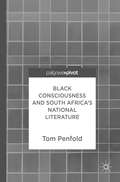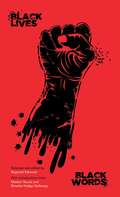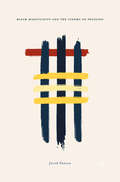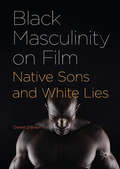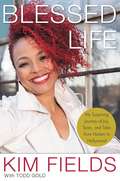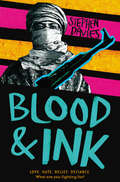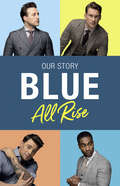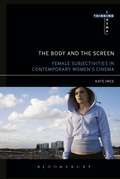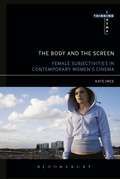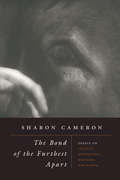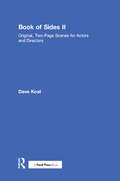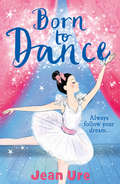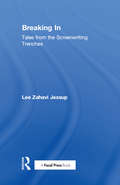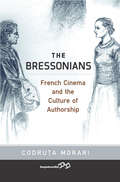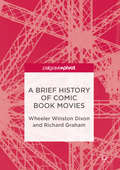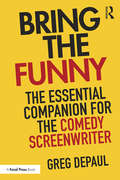- Table View
- List View
Black Consciousness and South Africa’s National Literature
by Tom PenfoldThis book analyses Black Consciousness poetry and theatre from the 1970s through to the present. South Africa’s literature, like its history, has been beset by disagreement and contradiction, and has been consistently difficult to pin down as one, united entity. Much existing criticism on South Africa’s national literature has attempted to overcome these divisions by discussing material written from a variety of different subject positions together. This book argues that Black Consciousness desired a new South Africa where African and European cultures were valued equally, and writers could represent both as they wished. Thus, a body of literature was created that addressed a range of audiences and imagined the South African nation in different ways. This book explores Black Consciousness in order to demonstrate how South African writers have responded in various ways to the changing history and politics of their country.
Black Lives, Black Words: 32 Short Plays (Oberon Modern Playwrights)
by Reginald EdmundDo Black Lives Matter? Selected and edited by the award winning American playwright Reginald Edmund, who produced Black Lives, Black Words across the US, which premiered in Chicago, July 2015. The international project has explored the black diaspora’s experiences in some of the largest multicultural cities in the world, Chicago, Minneapolis, Cleveland, Toronto and London. Over sixty Black writers from the UK, USA, and Canada have each written a short play to address Black issues today. Featured in this collection are: Reginald Edmund, Idris Goodwin, James Austin, Williams, Rachel Dubose, Becca C. Browne, Marsha Estell, Aaron Holland, Loy A. Webb, Lisa Langford, Christina Ham, Harrison David Rivers, Dominique Morisseau, Winsome Pinnock, Trish Cooke, Mojisola Adebayo, Rachel De-Lahay, Max Kolaru, Yolanda Mercy, Somalia Seaton, Courttia Newland, Luke Reece, Tawiah BenEben, M’Carthy Kanika Ambrose. Jordan Laffrenier. Meghan Swaby. Mary Ann Anane. Allie Woodson. Elliot Sagay. Amira Danan. Cat Davidson. Noelle Fourte and Kori Alston
Black Masculinity and the Cinema of Policing (PDF)
by Jared SextonThis book offers a critical survey of film and media representations of black masculinity in the early twenty-first-century United States, between President George W. Bush’s 2001 announcement of the War on Terror and President Barack Obama’s 2009 acceptance of the Nobel Peace Prize. It argues that images of black masculine authority have become increasingly important to the legitimization of contemporary policing and its leading role in the maintenance of an antiblack social order forged by racial slavery and segregation. It examines a constellation of film and television productions—from Antoine Fuqua’s Training Day to John Lee Hancock’s The Blind Side to Barry Jenkin's Moonlight—to illuminate the contradictory dynamics at work in attempts to reconcile the promotion of black male patriarchal empowerment and the preservation of gendered antiblackness within political and popular culture.
Black Masculinity on Film: Native Sons and White Lies
by Daniel O'BrienThis book provides wide-ranging commentary on depictions of the black male in mainstream cinema. O’Brien explores the extent to which counter-representations of black masculinity have been achieved within a predominately white industry, with an emphasis on agency, the negotiation and malleability of racial status, and the inherent instability of imposed racial categories. Focusing on American and European cinema, the chapters highlight actors (Woody Strode, Noble Johnson, Eddie Anderson, Will Smith), genres (jungle pictures, westerns, science fiction) and franchises (Tarzan, James Bond) underrepresented in previous critical and scholarly commentary in the field. The author argues that although the characters and performances generated in these areas invoke popular genre types, they display complexity, diversity and ambiguity, exhibiting aspects that are positive, progressive and subversive. This book will appeal to both the academic and the general reader interested in film, race, gender and colonial issues.
Blessed Life: My Surprising Journey of Joy, Tears, and Tales from Harlem to Hollywood
by Kim FieldsFrom "Facts of Life" to "Living Single" to "Dancing with the Stars" to wife and mom, here's the BLESSED LIFE of Kim Fields, veteran actress, TV personality, and star. Kim Fields has lived most of her life with people thinking they know her, which is understandable. From her first job on a Mrs. Butterworth syrup commercial at age 7, she has spent 40 years in the public eye. There were 9 years as Dorothy "Tootie" Ramsey on the classic sitcom The Facts of Life, 5 more in her 20s starring as Regine Hunter on the seminal coming-of-age show Living Single, and most recently appearing as herself on Real Housewives of Atlanta and Dancing with the Stars. Behind the camera, she has directed episodes of Kenan & Kel, Tyler Perry's Meet the Browns and House of Payne, and BET's Let's Stay Together. Between gigs, the pop culture icon's life has included theater, spoken word, music, speaking engagements, and simply being present to the point that she cannot go a day without someone stopping her to say, "When I was a kid, I wanted to be Tootie" or "You were my role model." Flattered and blessed, after four decades in the business, Kim finally understands the role she has played onscreen and off as a successful, outspoken African-American woman. However, for as much as she's been in the public eye, people have really never known her the way they think they have, and that's because she, herself, spent most of her life figuring herself out. Now, at age 48, she is ready to set the record straight. She says, "It's not that I've been misunderstood. It's that I finally feel like I understand me enough to tell the life story that I've been asked to write for years." It will be a chronicle of living, learning, and keen moments of self-discovery as she's journeyed through the many facets and chapters of life. Fields found faith at age 14 and has found God to be right there every step of the way since then.
Blood & Ink
by Stephen DaviesKadija is the music-loving daughter of a guardian of the sacred manuscripts of the ancient city of Timbuktu, Mali.Ali is a former shepherd boy, trained as a warrior for Allah.Tonight, the Islamist rebels are coming for Timbuktu. They will install a harsh regime of law and tear apart the peaceful world within the mud walls of the city. Television, football, radios, even music, will be banned. Kadija refuses to let go of her former life. And something in her defiance draws Ali to her.Which path will he choose?
Blue: Our Story
by Antony Costa Duncan James Lee Ryan Simon WebbeFor the first time, more than 15 years after four boys from London were first thrown together to form what would go on to become one of the most successful and infamous groups of the boyband era, Lee, Antony, Duncan and Simon tell their full, no-holds-barred story in their own inimitable words.
The Body and the Screen: Female Subjectivities in Contemporary Women’s Cinema (Thinking Cinema)
by Kate InceWinner of the British Association of Film, Television and Screen Studies Best Book Prize 2018Since the 1980s the number of women regularly directing films has increased significantly in most Western countries; in France, Claire Denis and Catherine Breillat have joined Agnès Varda in gaining international renown, while British directors Lynne Ramsay and Andrea Arnold have forged award-winning careers in feature film. This new volume in the "Thinking Cinema†? series draws on feminist philosophers and theorists from Simone de Beauvoir on to offer readings of a range of the most important and memorable of these films from the 1990s and 2000s, focusing as it does so on how the films convey women's lives and identities. Mainstream entertainment cinema traditionally distorts the representation of women, objectifying their bodies, minimizing their agency, and avoiding the most important questions about how cinema can "do justice" to female subjectivity. Kate Ince suggests that the films of independent women directors are progressively redressing the balance, reinvigorating both the narratives and the formal ambitions of European cinema. Ince uses feminist philosophers to interpret such films as Sex Is Comedy, Morvern Callar, White Material, and Fish Tank anew, suggesting that a philosophical understanding of female subjectivity as embodied and ethical should underpin future feminist film study.
The Body and the Screen: Female Subjectivities in Contemporary Women’s Cinema (Thinking Cinema)
by Kate InceWinner of the British Association of Film, Television and Screen Studies Best Book Prize 2018Since the 1980s the number of women regularly directing films has increased significantly in most Western countries; in France, Claire Denis and Catherine Breillat have joined Agnès Varda in gaining international renown, while British directors Lynne Ramsay and Andrea Arnold have forged award-winning careers in feature film. This new volume in the “Thinking Cinema” series draws on feminist philosophers and theorists from Simone de Beauvoir on to offer readings of a range of the most important and memorable of these films from the 1990s and 2000s, focusing as it does so on how the films convey women's lives and identities. Mainstream entertainment cinema traditionally distorts the representation of women, objectifying their bodies, minimizing their agency, and avoiding the most important questions about how cinema can "do justice" to female subjectivity. Kate Ince suggests that the films of independent women directors are progressively redressing the balance, reinvigorating both the narratives and the formal ambitions of European cinema. Ince uses feminist philosophers to interpret such films as Sex Is Comedy, Morvern Callar, White Material, and Fish Tank anew, suggesting that a philosophical understanding of female subjectivity as embodied and ethical should underpin future feminist film study.
The Bond of the Furthest Apart: Essays on Tolstoy, Dostoevsky, Bresson, and Kafka
by Sharon CameronIn the French filmmaker Robert Bresson’s cinematography, the linkage of fragmented, dissimilar images challenges our assumption that we know either what things are in themselves or the infinite ways in which they are entangled. The “bond” of Sharon Cameron’s title refers to the astonishing connections found both within Bresson’s films and across literary works by Tolstoy, Dostoevsky, and Kafka, whose visionary rethinkings of experience are akin to Bresson’s in their resistance to all forms of abstraction and classification that segregate aspects of reality. Whether exploring Bresson’s efforts to reassess the limits of human reason and will, Dostoevsky’s subversions of Christian conventions, Tolstoy’s incompatible beliefs about death, or Kafka’s focus on creatures neither human nor animal, Cameron illuminates how the repeated juxtaposition of disparate, even antithetical, phenomena carves out new approaches to defining the essence of being, one where the very nature of fixed categories is brought into question. An innovative look at a classic French auteur and three giants of European literature, The Bond of the Furthest Apart will interest scholars of literature, film, ethics, aesthetics, and anyone drawn to an experimental venture in critical thought.
The Bond of the Furthest Apart: Essays on Tolstoy, Dostoevsky, Bresson, and Kafka
by Sharon CameronIn the French filmmaker Robert Bresson’s cinematography, the linkage of fragmented, dissimilar images challenges our assumption that we know either what things are in themselves or the infinite ways in which they are entangled. The “bond” of Sharon Cameron’s title refers to the astonishing connections found both within Bresson’s films and across literary works by Tolstoy, Dostoevsky, and Kafka, whose visionary rethinkings of experience are akin to Bresson’s in their resistance to all forms of abstraction and classification that segregate aspects of reality. Whether exploring Bresson’s efforts to reassess the limits of human reason and will, Dostoevsky’s subversions of Christian conventions, Tolstoy’s incompatible beliefs about death, or Kafka’s focus on creatures neither human nor animal, Cameron illuminates how the repeated juxtaposition of disparate, even antithetical, phenomena carves out new approaches to defining the essence of being, one where the very nature of fixed categories is brought into question. An innovative look at a classic French auteur and three giants of European literature, The Bond of the Furthest Apart will interest scholars of literature, film, ethics, aesthetics, and anyone drawn to an experimental venture in critical thought.
The Bond of the Furthest Apart: Essays on Tolstoy, Dostoevsky, Bresson, and Kafka
by Sharon CameronIn the French filmmaker Robert Bresson’s cinematography, the linkage of fragmented, dissimilar images challenges our assumption that we know either what things are in themselves or the infinite ways in which they are entangled. The “bond” of Sharon Cameron’s title refers to the astonishing connections found both within Bresson’s films and across literary works by Tolstoy, Dostoevsky, and Kafka, whose visionary rethinkings of experience are akin to Bresson’s in their resistance to all forms of abstraction and classification that segregate aspects of reality. Whether exploring Bresson’s efforts to reassess the limits of human reason and will, Dostoevsky’s subversions of Christian conventions, Tolstoy’s incompatible beliefs about death, or Kafka’s focus on creatures neither human nor animal, Cameron illuminates how the repeated juxtaposition of disparate, even antithetical, phenomena carves out new approaches to defining the essence of being, one where the very nature of fixed categories is brought into question. An innovative look at a classic French auteur and three giants of European literature, The Bond of the Furthest Apart will interest scholars of literature, film, ethics, aesthetics, and anyone drawn to an experimental venture in critical thought.
The Bond of the Furthest Apart: Essays on Tolstoy, Dostoevsky, Bresson, and Kafka
by Sharon CameronIn the French filmmaker Robert Bresson’s cinematography, the linkage of fragmented, dissimilar images challenges our assumption that we know either what things are in themselves or the infinite ways in which they are entangled. The “bond” of Sharon Cameron’s title refers to the astonishing connections found both within Bresson’s films and across literary works by Tolstoy, Dostoevsky, and Kafka, whose visionary rethinkings of experience are akin to Bresson’s in their resistance to all forms of abstraction and classification that segregate aspects of reality. Whether exploring Bresson’s efforts to reassess the limits of human reason and will, Dostoevsky’s subversions of Christian conventions, Tolstoy’s incompatible beliefs about death, or Kafka’s focus on creatures neither human nor animal, Cameron illuminates how the repeated juxtaposition of disparate, even antithetical, phenomena carves out new approaches to defining the essence of being, one where the very nature of fixed categories is brought into question. An innovative look at a classic French auteur and three giants of European literature, The Bond of the Furthest Apart will interest scholars of literature, film, ethics, aesthetics, and anyone drawn to an experimental venture in critical thought.
The Bond of the Furthest Apart: Essays on Tolstoy, Dostoevsky, Bresson, and Kafka
by Sharon CameronIn the French filmmaker Robert Bresson’s cinematography, the linkage of fragmented, dissimilar images challenges our assumption that we know either what things are in themselves or the infinite ways in which they are entangled. The “bond” of Sharon Cameron’s title refers to the astonishing connections found both within Bresson’s films and across literary works by Tolstoy, Dostoevsky, and Kafka, whose visionary rethinkings of experience are akin to Bresson’s in their resistance to all forms of abstraction and classification that segregate aspects of reality. Whether exploring Bresson’s efforts to reassess the limits of human reason and will, Dostoevsky’s subversions of Christian conventions, Tolstoy’s incompatible beliefs about death, or Kafka’s focus on creatures neither human nor animal, Cameron illuminates how the repeated juxtaposition of disparate, even antithetical, phenomena carves out new approaches to defining the essence of being, one where the very nature of fixed categories is brought into question. An innovative look at a classic French auteur and three giants of European literature, The Bond of the Furthest Apart will interest scholars of literature, film, ethics, aesthetics, and anyone drawn to an experimental venture in critical thought.
The Bond of the Furthest Apart: Essays on Tolstoy, Dostoevsky, Bresson, and Kafka
by Sharon CameronIn the French filmmaker Robert Bresson’s cinematography, the linkage of fragmented, dissimilar images challenges our assumption that we know either what things are in themselves or the infinite ways in which they are entangled. The “bond” of Sharon Cameron’s title refers to the astonishing connections found both within Bresson’s films and across literary works by Tolstoy, Dostoevsky, and Kafka, whose visionary rethinkings of experience are akin to Bresson’s in their resistance to all forms of abstraction and classification that segregate aspects of reality. Whether exploring Bresson’s efforts to reassess the limits of human reason and will, Dostoevsky’s subversions of Christian conventions, Tolstoy’s incompatible beliefs about death, or Kafka’s focus on creatures neither human nor animal, Cameron illuminates how the repeated juxtaposition of disparate, even antithetical, phenomena carves out new approaches to defining the essence of being, one where the very nature of fixed categories is brought into question. An innovative look at a classic French auteur and three giants of European literature, The Bond of the Furthest Apart will interest scholars of literature, film, ethics, aesthetics, and anyone drawn to an experimental venture in critical thought.
Book of Sides II: Original, Two-Page Scenes for Actors and Directors
by Dave KostBook of Sides II: Original, Two-Page Scenes for Actors and Directors is the second book in the Book of Sides series by Dave Kost, featuring original, two-page, two-character scenes for use in acting, directing, and auditioning classes. While shorter than the traditional three-to-six-page scenes commonly used in classes, Book of Sides II features longer scenes than the first Book of Sides with greater character development, more reversals, and stronger climaxes. Balanced, structured scenes designed specifically for educational use challenge both actors and directors equally with objectives, obstacles, tactics, and subtext; Two-page length is ideal for high-intensity exercises and faster-paced workshops; Printed in easy-to-read film-script format with plenty of room for notes; Scenes are completely original and unencumbered by copyright, so students may film and post legally on the internet; Universally castable, so all roles can be played by actors of any gender, appearance, skill level, or ethnicity; Accessibly-written for modern students, helping them to focus on the fundamentals of performance and directing; Simple and conducive to performing in a classroom without sets, costumes, or special props. This book was written by an educator for educators and designed for use in the classroom. Never search for scenes again!
Book of Sides II: Original, Two-Page Scenes for Actors and Directors
by Dave KostBook of Sides II: Original, Two-Page Scenes for Actors and Directors is the second book in the Book of Sides series by Dave Kost, featuring original, two-page, two-character scenes for use in acting, directing, and auditioning classes. While shorter than the traditional three-to-six-page scenes commonly used in classes, Book of Sides II features longer scenes than the first Book of Sides with greater character development, more reversals, and stronger climaxes. Balanced, structured scenes designed specifically for educational use challenge both actors and directors equally with objectives, obstacles, tactics, and subtext; Two-page length is ideal for high-intensity exercises and faster-paced workshops; Printed in easy-to-read film-script format with plenty of room for notes; Scenes are completely original and unencumbered by copyright, so students may film and post legally on the internet; Universally castable, so all roles can be played by actors of any gender, appearance, skill level, or ethnicity; Accessibly-written for modern students, helping them to focus on the fundamentals of performance and directing; Simple and conducive to performing in a classroom without sets, costumes, or special props. This book was written by an educator for educators and designed for use in the classroom. Never search for scenes again!
Born to Dance (Dance Trilogy #1)
by Jean UreThe first in a brand-new series about dancing, friendship and following your dreams from best-loved author Jean Ure, whose books are described by Jacqueline Wilson as “funny, funky, feisty - and fantastic reads!”
Breaking In: Tales from the Screenwriting Trenches
by Lee JessupBreaking In: Tales from the Screenwriting Trenches is a no-nonsense, boots-on-the-ground exploration of how writers REALLY go from emerging to professional in today’s highly saturated and competitive screenwriting space. With a focus on writers who have gotten representation and broken into the TV or feature film space after the critical 2008 WGA strike and financial market collapse, the reader will learn from tangible examples of how success was achieved via hard work and specific methodology. This book includes interviews from writers who wrote major studio releases (The Boy Next Door), staffed on television shows (American Crime, NCIS New Orleans, Sleepy Hollow), sold specs and television shows, placed in competitions, and were accepted to prestigious network and studio writing programs. These interviews are presented as Screenwriter Spotlights throughout the book and are supported by insight from top-selling agents and managers (including those who have sold scripts and pilots, had their writers named to prestigious lists such as The Black List and The Hit List) as well as working industry executives. Together, these anecdotes, learnings and perceptions, tied in with the author's extensive experience in and knowledge of the industry, will inform the reader about how the industry REALLY works, what it expects from both working and emerging writers, as well as what next steps the writer should engage in, in order to move their screenwriting career forward.
Breaking In: Tales from the Screenwriting Trenches
by Lee JessupBreaking In: Tales from the Screenwriting Trenches is a no-nonsense, boots-on-the-ground exploration of how writers REALLY go from emerging to professional in today’s highly saturated and competitive screenwriting space. With a focus on writers who have gotten representation and broken into the TV or feature film space after the critical 2008 WGA strike and financial market collapse, the reader will learn from tangible examples of how success was achieved via hard work and specific methodology. This book includes interviews from writers who wrote major studio releases (The Boy Next Door), staffed on television shows (American Crime, NCIS New Orleans, Sleepy Hollow), sold specs and television shows, placed in competitions, and were accepted to prestigious network and studio writing programs. These interviews are presented as Screenwriter Spotlights throughout the book and are supported by insight from top-selling agents and managers (including those who have sold scripts and pilots, had their writers named to prestigious lists such as The Black List and The Hit List) as well as working industry executives. Together, these anecdotes, learnings and perceptions, tied in with the author's extensive experience in and knowledge of the industry, will inform the reader about how the industry REALLY works, what it expects from both working and emerging writers, as well as what next steps the writer should engage in, in order to move their screenwriting career forward.
The Bressonians: French Cinema and the Culture of Authorship
by Codruţa MorariHow should we understand film authorship in an era when the idea of the solitary and sovereign auteur has come under attack, with critics proclaiming the death of the author and the end of cinema? The Bressonians provides an answer in the form of a strikingly original study of Bresson and his influence on the work of filmmakers Jean Eustache and Maurice Pialat. Extending the discourse of authorship beyond the idea of a singular visionary, it explores how the imperatives of excellence function within cinema’s pluralistic community. Bresson’s example offered both an artistic legacy and a creative burden within which filmmakers reckoned in different, often arduous, and altogether compelling ways.
A Brief History of Comic Book Movies
by Wheeler Winston Dixon Richard GrahamA Brief History of Comic Book Movies traces the meteoric rise of the hybrid art form of the comic book film. These films trace their origins back to the early 1940s, when the first Batman and Superman serials were made. The serials, and later television shows in the 1950s and 60s, were for the most part designed for children. But today, with the continuing rise of Comic-Con, they seem to be more a part of the mainstream than ever, appealing to adults as well as younger fans. This book examines comic book movies from the past and present, exploring how these films shaped American culture from the post-World War II era to the present day, and how they adapted to the changing tastes and mores of succeeding generations.
A Brief History of Comic Book Movies
by Wheeler Winston Dixon Richard GrahamA Brief History of Comic Book Movies traces the meteoric rise of the hybrid art form of the comic book film. These films trace their origins back to the early 1940s, when the first Batman and Superman serials were made. The serials, and later television shows in the 1950s and 60s, were for the most part designed for children. But today, with the continuing rise of Comic-Con, they seem to be more a part of the mainstream than ever, appealing to adults as well as younger fans. This book examines comic book movies from the past and present, exploring how these films shaped American culture from the post-World War II era to the present day, and how they adapted to the changing tastes and mores of succeeding generations.
Bring the Funny: The Essential Companion for the Comedy Screenwriter
by Greg DePaulA sharp, funny book about comedy screenwriting from a successful screenwriter that uses recent – as in this century – movies you've actually seen as examples. Greg DePaul (Screenwriter, Bride Wars, Saving Silverman) has sold scripts to Miramax, Fox, Disney, New Line, Sony, MGM and Village Roadshow. He's worked with comedy stars like Jack Black, Kate Hudson, Jason Biggs and Amanda Peet. Now Greg takes everything he knows about writing comedy and breaking into the biz, tosses it into a blender and serves up this tasty, fat-free smoothie of a book that’s easy to read, brutally honest, and straight from the heart ... of Hollywood. Bring the Funny is chock full o' tricks, strategies and insider terms used by successful comedy screenwriters, including: Comic Justice Wrylies Genre-Bending Shadow Characters The BDR's The Two-Hander The Conceit Comedic Escalation Gapping A.I.C. Fish Outta Water The Idea Factory Really Important Comedy Screenwriting Rules Number 99 and 100 If you're looking to write funnier and better screenplays, you want this book. But if you're ready to pack up your car, drive out to L.A., and dive into a career as a comedy screenwriter, you need this book. Now. Buy it, jam it into your pocket, and hit the gas. Greg's got your back.
Bring the Funny: The Essential Companion for the Comedy Screenwriter
by Greg DePaulA sharp, funny book about comedy screenwriting from a successful screenwriter that uses recent – as in this century – movies you've actually seen as examples. Greg DePaul (Screenwriter, Bride Wars, Saving Silverman) has sold scripts to Miramax, Fox, Disney, New Line, Sony, MGM and Village Roadshow. He's worked with comedy stars like Jack Black, Kate Hudson, Jason Biggs and Amanda Peet. Now Greg takes everything he knows about writing comedy and breaking into the biz, tosses it into a blender and serves up this tasty, fat-free smoothie of a book that’s easy to read, brutally honest, and straight from the heart ... of Hollywood. Bring the Funny is chock full o' tricks, strategies and insider terms used by successful comedy screenwriters, including: Comic Justice Wrylies Genre-Bending Shadow Characters The BDR's The Two-Hander The Conceit Comedic Escalation Gapping A.I.C. Fish Outta Water The Idea Factory Really Important Comedy Screenwriting Rules Number 99 and 100 If you're looking to write funnier and better screenplays, you want this book. But if you're ready to pack up your car, drive out to L.A., and dive into a career as a comedy screenwriter, you need this book. Now. Buy it, jam it into your pocket, and hit the gas. Greg's got your back.
